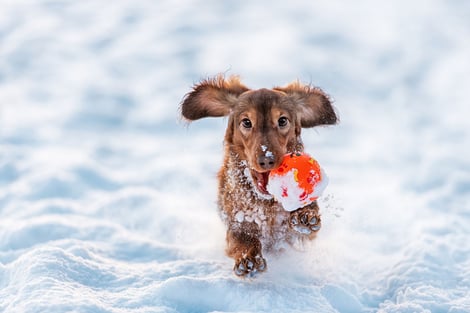Dogs in Cold Weather: Tips and Tricks to Keep them Warm and Happy

It’s winter now, and we all know dogs need to get out of the house to exercise, pee, and poop. Walking with dogs is one of the best things in life—for pooches and humans.
You’ve seen the ads for fur-lined dog parkas and fancy booties. Is that really necessary?
What do dog owners need to know to keep their dogs safe and healthy during the cold months?
Know Your Dog’s Cold Tolerance
Think of the difference between a husky (a large dog with a thick coat and bred to pull sleds in the snow) and a chihuahua (a tiny dog with a very short coat and short legs originally bred in warmer climates like Mexico). Dogs come from all over the globe, and different breeds and mixes have very different abilities to tolerate cold temperatures and snow.
Short-haired or hairless dogs feel the cold like we do—without our clothes. These dogs that also have short legs, like chihuahuas and dachshunds, are closer to the ground and will get cold when their tummies (and other body parts) touch ice or snow. So these dogs often need some clothing and might need to take shorter walks in the winter.
Limit Outside Time
When you are walking your dog, both of you will want to dress for the cold weather. Some dogs will tolerate coats and booties; others have magical abilities to take them off. Even if you have a hardy dog with a thick coat, they shouldn’t be left outside on their own for very long in the cold. If you don’t want to be outside for long, then do your dog a favor and don’t let them stay outside for very long.
Though, I have seen some adorable videos online where people are calling their dogs to come inside and they're thoroughly enjoying being outdoors in the cold and snow. So check back with them often to give them the chance to come inside.
Consider Your Dog’s Age and Health
If you have an older dog with arthritis, they will probably need shorter walks in the winter. Dogs with other diseases, like diabetes, heart or kidney disease, or hormonal imbalances, might have difficulty regulating their body temperature.
Puppies will also need to be inside if it’s very cold out. They are still babies, after all.
Keep an Eye on Those Paws
Dogs have pads on the bottom of their feet that can be damaged by extreme cold and products that are put on the streets or sidewalks to prevent ice from forming (see below).
If your dog stops walking to lick or bite at their paws, they might be uncomfortable because they have ice or snow between their pads (or their paws are irritated by de-icers). Clipping the hair between the pads can help, so there is less chance for snow or ice to attach.
Some pet parents use petroleum jelly or other paw protection products on their pups’ pads to help protect them from irritants.
Avoid Shaving and Bathing in the Winter
Even if your dog is the type that needs regular grooming, don’t shave them down to the skin in the winter. They need that fur to keep them warm. In the cold, let them keep their fur and just trim between the toes to keep their fur from getting tangled.
Also, bathing dogs removes some important oils from their skin. Limit baths in the winter to keep their skin from getting dry and itchy. If your pet needs a bath, ask your vet to recommend a moisturizing shampoo.
Avoid Salt and De-Icing Products
Some products that people use to de-ice roads and sidewalks are toxic to dogs, which can hurt their paws or make them sick if they eat enough of the product.
Some de-icers are marketed as “pet-friendly” options. However, caution is still advised. While you can control the kinds of de-icer products you put on your driveway or sidewalks, others may use products that can be harmful in certain situations.
The best advice is for you to take care of their paws when you get back home, even if you applied a paw product before you started your walk. Wipe down their paws and tummies so they don’t lick the chemicals off.
Know That Antifreeze Kills
While antifreeze isn't necessarily thought of as a winter-time hazard per se, other winter-specific products contain the same poisonous substance.
The American Association of Poison Control Centers reports that ethylene glycol, used in antifreeze, is the second most common cause of poisoning in pets. It is estimated to kill between 10,000 and 90,000 animals every year. The chemical has a sweet taste, and when it leaks from cars, dogs, or cats that drink it, they can get very sick quickly. Watch for antifreeze spills and leaks, and store these types of chemicals to keep your pet out of harm's way.
Other products that contain ethylene glycol include windshield deicers, brake fluid, motor oil, solvents, printer ink cartridges, and snow globes.
A dog that ingests antifreeze will act drunk and start throwing up, so it’s important to get help from an emergency veterinarian right away. If you live in Northeast Ohio, the list of emergency veterinary clinics is located on our website. Otherwise, call your regular veterinarian or check out their website. They usually mention the emergency veterinary clinic where you can take your pup after hours or in an emergency.
Cold Cars Are Dangerous
Most people know that pets can overheat in cars in the summer, but leaving your pet in a car in the winter is like leaving them in a refrigerator or freezer. It’s best not to leave them alone in a car, no matter what the season.
And Some Good News…
The folks at the Association for the Prevention of Cruelty to Animals (ASPCA) suggest you feed your pet a little more during the winter because they burn more calories staying warm. As always, make sure they have access to fresh, clean water.
You can also get some extra snuggle time by giving your dog a warm dog bed or blanket.
Then take a picture to share with your family. How cute is that?

